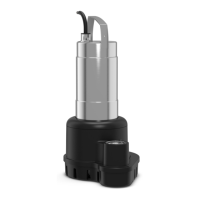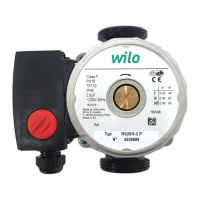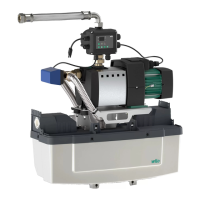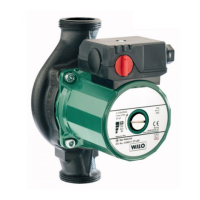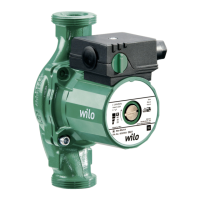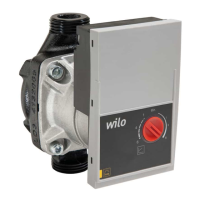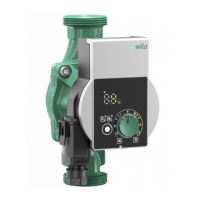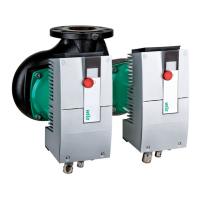en Decommissioning/dismantling
20 WILO SE 2017-03
no longer be exceeded. CAUTION!If the pump does
not start, switch off the pump immediately. Remove
the fault before reactivating the pump!
Place pumps which are installed as portable pumps on a
firm surface so they are level. If pumps have fallen over,
place them upright again before activating them. Se-
curely attach the pump with screws in case of difficult
surfaces.
Pump with attached float switch and plug
▪Single-phase current version: After inserting the plug
into the socket, the pump is ready for operation. The
pump is switched on and off automatically depending
on the fill level.
▪Three-phase version: After inserting the plug into the
socket, the pump is ready for operation. The pump is
controlled via two switches on the plug:
– HAND/AUTO: Determines if the pump is switched on
and off directly (HAND) or depending on the fill level
(AUTO).
– ON/OFF: Switch pump on and off.
Pump with attached plug
▪Single-phase current version: After inserting the plug in
the socket, the pump is switched on.
▪Three-phase version: After inserting the plug into the
socket, the pump is ready for operation. The pump is
switched on and off with the ON/OFF switch.
Pumps with free cable end
The pump must be switched on and off using a separ-
ate operating point (on/off switch, switchgear)
provided by the customer.
7.6 During operation
WARNING
Amputation of limbs due to rotating com-
ponents!
No persons must be present in the work area of the
pump! There is risk of (serious) injuries due to rotat-
ing components! No persons must be present in the
work area of the pump during start-up or operation.
WARNING
Risk of burns from hot surfaces!
Motor housing can become hot during operation. It
may cause burns. Allow the pump to cool down at
ambient temperature after switching it off!
NOTICE
Delivery problems due to water level being
too low
The hydraulics are self-venting. As a result, smaller
air cushions are dissolved during the pumping pro-
cess. If the level of the fluid is lowered too much, the
volume flow can be interrupted. The minimum per-
missible water level must reach the upper edge of
the hydraulics housing!
When operating the pump, observe the locally applic-
able regulations on the following topics:
▪Work safety
▪Accident prevention
▪Handling electrical machines
Strictly adhere to the responsibilities of the personnel
specified by the operator. All personnel are responsible
for ensuring that the responsibilities of the personnel
and the regulations are observed!
Due to their design, centrifugal pumps have rotating
parts that are easily accessible. Depending on the oper-
ating condition, sharp edges can develop on these
parts. WARNING!This can lead to cuts and limbs may
be amputated and severed! Check the following at
regular intervals:
▪Operating voltage (+/-10% of the rated voltage)
▪Frequency (+/-2% of the rated frequency)
▪Power consumption between individual phases (max.
5%)
▪Voltage difference between the individual phases
(max.1%)
▪Max. switching frequency
▪Minimum water submersion depending on the operat-
ing mode
▪Inlet: no air intake
▪Level control device/dry-running protection: Switching
points
▪Quiet/low-vibration running
▪All gate valves open
8 Decommissioning/dismantling
8.1 Personnel qualifications
▪Operation/control: Operating personnel must be in-
structed in the functioning of the complete system.
▪Electrical work: Electrical work must be carried out by a
qualified electrician (in accordance with EN50110-1).

